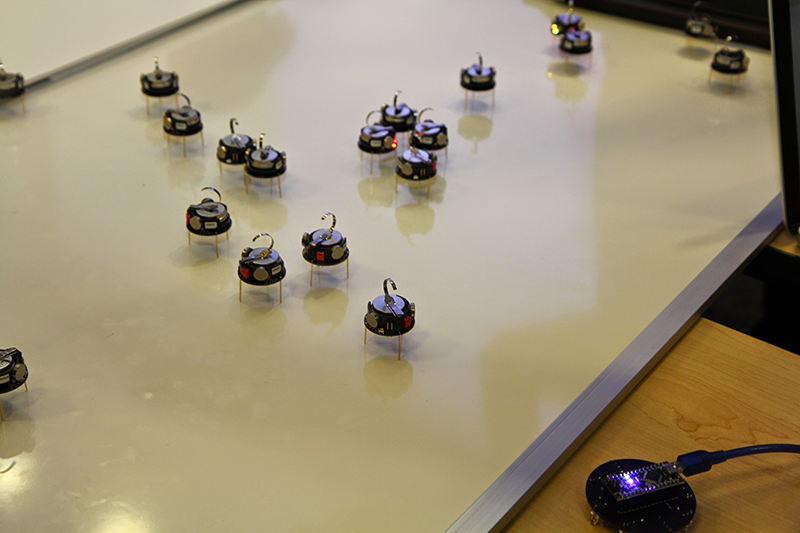For my final project I would like to look at Swarm behaviour. I have had an intial research binge to see what work has been done on this already. There are a few examples available. I have come to the conclusion thatI would like to mimic swarm behaviour in land based drones using ultra-wideband localisation. See below as to how I came to this conclusion.
I was initally quite ambitious in that I wanted to create a swarm drone based on Daniele Ingrassia's design (FabAcademy 2015) After an initial research binge this looks to be a very challenging task. This is mainly due to current localisation technology. The sensors used on drones (accelorometer/gyroscope/magentometer) give a good idea of movement, however they do not know where they are in space.

There are a few examples of robots which exhibit swarm or stigmeric behaviour that use various methods of communication and localisation.
The following is very brief overviews of very complex projects so I encourage you to investigate through the links rather than quote any information from here.
kilobot_project
These are interesting robots that communicate with each other via Infra red. This is very short range communication. These drones interestingly exhibit the behaviour we might see in insect swarms where messages are passed through the swarm via each unit. aka the signal is propageted through the swarm. The robots are also controlled by an over head infra red scanner.

One of the nice things about this project is the cheap hardware they came up with to test out the very complex behaviours they are trying to exhibit. I should be looking at something similar to test out the behaviour I am trying to mimic.
Zooids

The robots localise and communicate via a high speed DLP light projector. Photodiodes on the robots decode a projected code into a location.
I want to look at more independant communication and localisation.
pixelbots
These robots are localised using an overhead camera, again what I would like to get away from. There is some interesting documentation on the algorithms controlling swarm behaviour which will require further study.
ardupilot and lidar
This is an interesting project that involves using lidar to sense the environment around the robot. This is something I would need for a swarm a sytem to behave intelligently within its environment. But it is knowing where each unit in a swarm is within this environment aka communication and localisation.
The DWM1000 Chip aka ultra-wideband localisation
pozyx
This is the best example with the best documentation as to how and why this system can achieve cm accuracy, far better than other systems.
There are other resources available online of projects that have used this system either with the pozyx board direcly or other means:I see the ideal situation is using a combination of lidar to map the environment and UWB localisation. From start a reference location can be setup. Inital drones could map the environment In and around the the reference area. From this a new reference area could be created with DWM1000 anchors moving to a known location in a new environment with subsequent scanning, and so on and so on.
This is purely a theory and I could see accumulated errors becoming a big issue with each subsequent cycle. Also not to mention that this is no doubt a phenominally huge project. So, to break it down I will look at using the DWM1000 chip to localise ground based drones and apply some stigmeric intelligence in the system.
birds of a feather... track seven neighbours to flock together http://www.princeton.edu/main/news/archive/S36/02/56I00/index.xml?section=topstories DXF TO SCFR http://www.micromagicsystems.com/dxf-converter/4523812840 EAGLE OUTLINES